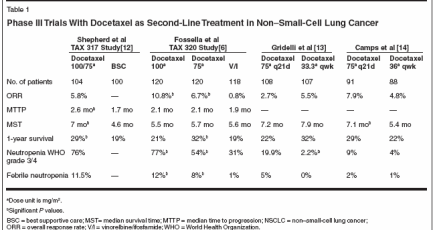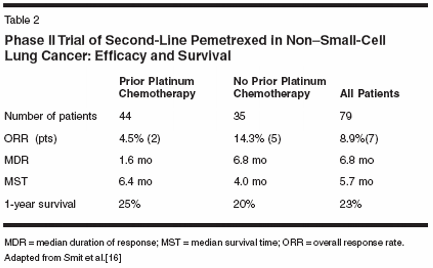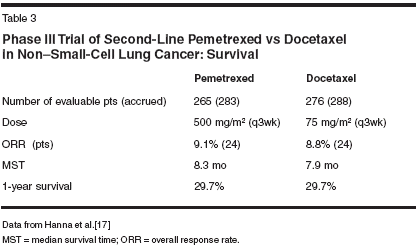Pemetrexed in Second-Line Treatment of Non–Small-Cell Lung Cancer
According to the updated 2004 guidelines of the American Societyof Clinical Oncology (ASCO) on the treatment of advanced non–smallcelllung cancer (NSCLC), docetaxel (Taxotere) can be considered thestandard second-line chemotherapy in patients relapsing after frontlinetherapy. This was based on two phase III trials (TAX 317 and TAX320) that demonstrated the superiority of docetaxel at 75 mg/m2 in theparameters of survival, quality of life, and disease/symptom controlwhen compared to best supportive care or alternative single-agent chemotherapy.The response rate was approximately 6%, with a mediansurvival time of 7 months and a 1-year survival rate of 30%. Despitethe activity demonstrated, this schedule showed an important toxicityprofile, with grade 3/4 neutropenia and febrile neutropenia occurringin 70% and 11% of patients, respectively. However, the results obtainedby these studies stimulated research interest in new drugs for this diseasesetting. Pemetrexed (Alimta), a new multitargeted antifolate, hasachieved promising results in NSCLC treatment, as a single agent or incombination with other drugs. In the second-line setting, a large phaseII study demonstrated good activity of pemetrexed, with an acceptabletoxicity profile. This led to a phase III registration trial that comparedpemetrexed at 500 mg/m2 to the standard docetaxel dose of 75 mg/m2.While results from this trial demonstrated a similar efficacy of the tworegimens in response rate and survival, pemetrexed achieved a bettersafety profile. These results support the use of pemetrexed as a newoption in the second-line treatment of NSCLC.
ABSTRACT: According to the updated 2004 guidelines of the American Societyof Clinical Oncology (ASCO) on the treatment of advanced non-smallcelllung cancer (NSCLC), docetaxel (Taxotere) can be considered thestandard second-line chemotherapy in patients relapsing after frontlinetherapy. This was based on two phase III trials (TAX 317 and TAX320) that demonstrated the superiority of docetaxel at 75 mg/m2 in theparameters of survival, quality of life, and disease/symptom controlwhen compared to best supportive care or alternative single-agent chemotherapy.The response rate was approximately 6%, with a mediansurvival time of 7 months and a 1-year survival rate of 30%. Despitethe activity demonstrated, this schedule showed an important toxicityprofile, with grade 3/4 neutropenia and febrile neutropenia occurringin 70% and 11% of patients, respectively. However, the results obtainedby these studies stimulated research interest in new drugs for this diseasesetting. Pemetrexed (Alimta), a new multitargeted antifolate, hasachieved promising results in NSCLC treatment, as a single agent or incombination with other drugs. In the second-line setting, a large phaseII study demonstrated good activity of pemetrexed, with an acceptabletoxicity profile. This led to a phase III registration trial that comparedpemetrexed at 500 mg/m2 to the standard docetaxel dose of 75 mg/m2.While results from this trial demonstrated a similar efficacy of the tworegimens in response rate and survival, pemetrexed achieved a bettersafety profile. These results support the use of pemetrexed as a newoption in the second-line treatment of NSCLC.
Lung cancer is the leading causeof cancer death worldwide, accountingfor 1.1 million deaths(17.8% of all cancer deaths) in theyear 2000.[1] Non-small-cell lungcancer (NSCLC) comprises 85% ofall lung cancer cases, and almost 45%of patients present with distant metastasisat diagnosis. In the first-linetreatment setting, platinum-based chemotherapyprolongs survival and improvesdisease-related symptoms andquality of life when compared to bestsupportive care.[2,3] Moreover, newdrug development and the investigationof novel chemotherapeutic combinationshave resulted in a furtherimprovement in progression-free survival,overall survival, and quality oflife.[4] Nevertheless, 5-year survivalrates still remain extremely poor, andprogressively more patients receivesecond-line treatment following failurein first-line setting.Docetaxel (Taxotere), an antimicrotubuleagent was first approved byUS Food and Drug Administration(FDA) and also recommended in theupdated 2004 guidelines of the AmericanSociety of Clinical Oncology(ASCO) for second-line therapy usein patients with progressive diseasefollowing platinum-based chemotherapy.[5] Despite potent activity, docetaxelis associated with significanttoxicity,[6] and in clinical practice,its use remains indicated for patientswith good performance status (PS).Pemetrexed (Alimta) is a novel,multitargeted antifolate that inhibitsat least three enzymes involved inDNA synthesis pathways: thymidylatesynthase (TS), dihydrofolate reductase(DHFR), and glycinamideribonucleotide formyltransferase(GARFT). After phase I studies assessed an optimal pemetrexed dose of500 mg/m2 once every 3 weeks,[7]several trials investigated its role as asingle agent and in combination chemotherapywith cisplatin as first-linetreatment of NSCLC.[8,9] In this article,we present a brief overview ofcurrent second-line options in thetreatment of NSCLC, and we also reviewtrials investigating the role ofpemetrexed as a single agent in second-line chemotherapy for NSCLC.

Second-Line Chemotherapyfor NSCLCSeveral phase II studies investigatedsingle-agent chemotherapy withthird-generation drugs as second-linetreatment for recurrent NSCLC. Responserates ranged from 3% achievedwith paclitaxel (median survival 4.5months) to 19% with gemcitabine(Gemzar) (median survival 8.0months).[10,11] The approval of docetaxelby the FDA and the EuropeanAgency for the Evaluation of MedicalProducts (EMEA) as standardtreatment in this setting was based ontwo phase III studies.In the Tax 317 trial of Shepherd etal,[12] 204 patients were randomizedto receive docetaxel at 100 mg/m2 every3 weeks or best supportive carealone (Table 1). After an interim-safetyanalysis recorded a higher treatment-related death rate in thedocetaxel arm, the dose was reducedto 75 mg/m2.The objective overall response ratewas 5.8% in the docetaxel arm, withan Eastern Cooperative OncologyGroup (ECOG) PS of 0 as the bestpredictor of response. All efficacyparameters were significantly improvedfor patients treated with docetaxelthan the best supportive caregroup, with a time to progression of2.6 vs 1.7 months (P < .001), a medianoverall survival of 7 vs 4.6 months(P = .047), and a 1-year survival rateof 29% vs 19%. Even better resultswere reported in the subset of patientswho received docetaxel at 75 mg/m2vs the corresponding best supportivecare group for median survival (7.5vs 4.6 months [P = .01]) as well as 1-year survival percentage (37% vs12%; P = .003).Hematologic toxicity was the mostrelevant grade 3/4 toxicity observed,with rates of neutropenia and febrileneutropenia of 76% and 11.5%, respectively.Despite the high rate ofside effects reported, at the qualityof-life evaluation performed with boththe Lung Cancer Symptom Scale andthe European Organization for Researchand Treatment of Cancer(EORTC) instruments, docetaxeltreatedpatients reached higher scoresin terms of pain control, weight loss,and PS. Furthermore, patients receivingdocetaxel at 75 mg/m2 requiredsignificantly fewer opioid and nonopioiddrugs.Similar results were obtained inthe TAX 320 trial reported by Fossellaet al[6] summarized in Table 1. Inthis study, docetaxel at 100 mg/m2 or75 mg/m2 was compared with an alternativesingle-agent chemotherapy,either vinorelbine (Navelbine) or ifosfamide(Ifex), known as V/I. Overall,373 patients were randomized, and358 were evaluable for response andsurvival.The overall response rates were10.8%, 6.7%, and 0.8% for the docetaxel100 mg/m2 and 75 mg/m2 andthe control groups, respectively. Timeto progression and overall survival(range: 5.5 to 5.7 months) were comparablein all groups, but 1-year survivalwas significantly in favor of thedocetaxel 75 mg/m2 group vs control(32% vs 19%; P = .025). The docetaxel100 mg/m2 group achieved a 1-year survival rate of 21%, notsignificantly different from the controlgroup. The progression-free survivalat 26 weeks was significantlyincreased for patients receiving docetaxelcompared to V/I (P = .005).


The incidence of neutropenia andfebrile neutropenia was significantlyhigher in both docetaxel groups thanin the V/I group; moreover, two toxicdeaths were observed in both the docetaxel100 mg/m2 and V/I groups, butnot in the docetaxel 75 mg/m2 group.On the basis of data obtained inthe TAX 317 and 320 trials, docetaxelat 75 mg/m2 was considered a newcontrol group in other forthcomingstudies conducted in the second-linesetting for treatment of NSCLC.To decrease docetaxel toxicity whilemaintaining efficacy, two phase III trialscompared the 3-week 75 mg/m2schedule with a weekly schedule. Theresults are summarized in Table 1. Thepreliminary results of the Italian multicenterstudy (n = 220; 215 evaluable)of Gridelli et al[13] show thatweekly docetaxel has a better impacton aspects of quality of life (eg, coginitivefunction, pain, cough, hair loss)with a comparable activity for the3-week vs the standard schedule (overallresponse: 2.7% vs 5.5%; mediansurvival: 7.2 vs 7.9 weeks).However, Camps and colleagues[14] in their Spanish study (n= 240; 179 evaluable) did not confirmthe advantage previously reportedfor the safety profile with theweekly schedule. While the safety profileswere similar, neutropenia, leukopenia,alopecia, and hepatic toxicitywere more common in the 3-weekschedule, while diarrhea, mucositis,and dyspnea were more common inthe standard schedule. The overall responserate, time to progression, and1-year survival rates did not differbetween groups, the every-3-weekschedule achieved significantly improvedmedian survival (7.1 vs 5.4months; P = .004).Overall, data from such trials generateda growing interest in the developemntand evaluation of new agentsfor use in the second-line treatment ofNSCLC.Pemetrexed in Second-LineChemotherapy for NSCLCSeveral studies exploring the activityand safety profile of pemetrexedas an anticancer compounddemonstrated a good tolerability profile,with severe myelosuppression andskin rush as the dose-limiting toxicities.As second-line therapy, it hasbeen investigated in a phase II trial,and consequently, in a phase III randomizedtrial vs the standard docetaxelas a comparator.In a large phase II trial conductedin Europe and Australia, Smit et al[15]administered pemetrexed to 81 refractorypatients (79 evaluable), definedas patients who progressed duringfirst-line treatment or within 3 monthsafter completion of first-line treatment.Accrual was carefully restricted topatients with demonstrated diseaseprogression by computed tomographic(CT) scan or x-ray.Patients were required to have bidimensionallymeasurable disease andan estimated life expectancy of morethan 8 weeks. Patients with an ECOGPS of 2 (considered unfit) were notaccrued. Patients received pemetrexed500 mg/m2 in 10 minutes intravenously(IV) every 3 weeks, and were stratified according to prior treatment: platinum-containing regimens (n = 45) vsno platinum-containing regimens (n= 36). Furthermore, all patients receivedpremedication with oral dexamethasoneonce every 12 hours,starting 24 hours before treatment andcontinuing for four doses after treatment.At the time of study initiationand completion, folic acid and vitaminB12 supplementation were not yet systematicallyimplemented, and patientsdid not receive that premedication.Table 2 summarizes the results ofthis study. The overall response ratewas 8.9%, and all but one patient whoresponded to pemetrexed had previouslyresponded to first-line treatment.Response rate was higher in the platinum-naive patients (14.3% vs 4.5%),but in this subgroup, the median survivaltime was only 4 months vs 6.4months in patients who were pretreatedwith a platinum compound.Pemetrexed was well tolerated,with 35% of patients experiencinggrade 3/4 neutropenia. Nevertheless,three toxic deaths associated with neutropenia-related sepsis were recorded.The use of oral prophylacticdexamethasone at any cycle reducedthe incidence of grade 3 skin rash toonly four patients.The favorable results obtained inthis trial led to a phase III randomizedregistration trial for comparing pemetrexedto the standard docetaxel assecond-line therapy in patients withNSCLC. Moreover, subsequent studiesshowed that the frequency of severemyelosuppression was directlyrelated to the folate and vitamin B12status of the patients. The levels ofhomocysteine, a measure of folate andvitamin B12 status, were directly relatedto neutropenia and infection-toxicitiesthat are associated with a greaterrisk of death. Folic acid and vitaminB12 supplementation was shown toreduce toxicity and to lower homocysteinelevels.[16] Vitamin supplementationwas thus adopted as an integralpart of pemetrexed treatment.From March 2001 to February2002, Hanna et al accrued on-study571 NSCLC patients who had previouslyreceived only one first-line chemotherapyregimen into a randomized,multicenter phase III registration trial.[17] (This trial was the largest phaseIII trial of second-line NSCLC reportedto date.) Patients received pemetrexedat 500 mg/m2 IV day 1 ordocetaxel at 75 mg/m2 IV day 1, every21 days. In the pemetrexed arm,patients were premedicated with corticosteroids,folic acid, and vitaminB12; patients in the docetaxel arm receivedcorticosteroids. Ninety percentof patients had previously receivedplatinum therapy, while 28% had receivedtaxanes. The primary end pointwas overall survival; secondary endpoints included toxicity, response rate,progression-free survival, and changesin the average symptom burden index.There was no overall differencebetween the study arms in efficacy(summarized in Table 3). The mediansurvival time was 8.3 months for pemetrexedvs 7.9 months for docetaxel.The overall response rates were 9.1%vs 8.8% for pemetrexed and docetaxel,respectively, and no difference betweenthe two arms was observed for symptomrelief.There was a statistically significantdifference between arms in regardto toxicity in favor ofpemetrexed. Patients receiving docetaxel(vs pemetrexed) were more likelyto experience grade 3/4 neutropenia(40.2% vs 5.3%; P < .001), febrileneutropenia (12.7% vs 1.9%; P < .001), infections with grade 3/4 neutropenia(3.3% vs 0%; P = .004), andalopecia (37.7% vs 6.4%; P < .001)compared to patients in the pemetrexedarm. Moreover, the requirementsfor granulocyte colony-stimulatingfactor (G-CSF)/granulocyte-macrophagecolony-stimulating factor (GMCSF)were increased in the docetaxelarm (19.2% vs 2.6% of cycles; P < .001). Moreover, hospitalization attributableto either febrile neutropeniaor drug-related adverse events wasmore common among patients in thedocetaxel arm vs those in the pemetrexedgroup (13.4% vs 1.5%, P < .001; 40.6% vs 31.7%, P = .092, respectively).The data demonstrate that pemetrexedpossesses an improved safetyprofile when compared with docetaxelin the second-line setting, and it isan effective agent in second-line chemotherapyin NSCLC.ConclusionThe new multitargeted antifolatepemetrexed is directed to cellular targetsthat are distinct from those commonlytargeted by conventional agentscurrently used in the management ofNSCLC. This lack of cross-resistancemight take advantage of clinical synergismwhen pemetrexed is combinedwith other agents that possess highactivity in the first-line setting, as wellas in salvage therapy for patients whoare resistant to standard treatments.The optimal administration of second-line treatment in NSCLC is currentlyunclear, as are the prognosticand/or predictive selection factors forresponse to further therapy regimen.In this regard, a phase II study conductedby Smit et al[15] reported thatpemetrexed achieved good activity inselected patients who entered on studywith a common ("poor") prognosticfactor (eg, resistance to first-line platinum-based therapy). The overall responserate was 9%, with a 1-yearsurvival rate of 23% data comparableto that obtained with other agents inthis setting.Recent data from a randomizedphase III trial by Hanna and colleagues[17] demonstrated that pemetrexedand the standard triweeklydocetaxel achieved comparable efficacy,but patients in the pemetrexedgroup reported a better safety profilefor hematologic and nonhematologictoxcity, and improved quality of life.Moreover, the introduction of dailyoral folate and intramuscular vitaminB12 supplementation every 9 weeks,independent of the vitamin level ofthe patients, allowed investigators toevaluate properly the efficacy andsafety profile of the regimen in relationto dose intensity.Due to these results, in the summerof 2004 pemetrexed was approved bythe FDA as single-agent chemotherapyfor second-line treatment in recurrentNSCLC; thus it can be considered astandard treatment option in thissetting.
Disclosures:
The authors have nosignificant financial interest or other relationshipwith the manufacturers of any productsor providers of any service mentioned in thisarticle.
References:
1.
Parkin DM, Bray F, Ferlay J, et al: Estimatingthe world cancer burden: Globocan2000. Int J Cancer 94:153-156, 2001.
2.
Chemotherapy in non-small cell lung cancer:A meta-analysis using updated data on individualpatients from 52 randomised clinicaltrials. Non-small Cell Lung Cancer CollaborativeGroup. BMJ 311:899-909, 1995.
3.
Cullen MH, Billingham LJ, WoodroffeCM, et al: Mitomycin, ifosfamide, and cisplatinin unresectable non-small-cell lung cancer:Effects on survival and quality of life. J ClinOncol 17:3188-3194, 1999.
4.
Bonomi P, Kim K, Fairclough D, et al:Comparison of survival and quality of life inadvanced non-small-cell lung cancer patientstreated with two dose levels of paclitaxel combinedwith cisplatin versus etoposide withcisplatin: Results of an Eastern CooperativeOncology Group trial. J Clin Oncol 18:623-631, 2000.
5.
Pfister DG, Johnson DH, Azzoli CG, etal: American Society of Clinical Oncologytreatment of unresectable non-small-cell lungcancer guideline: Update 2003. J Clin Oncol22:330-353, 2004.
6.
Fossella FV, DeVore R, Kerr RN, et al:Randomized phase III trial of docetaxel versusvinorelbine or ifosfamide in patients with advancednon-small-cell lung cancer previouslytreated with platinum-containing chemotherapyregimens. The TAX 320 Non-Small Cell LungCancer Study Group. J Clin Oncol 18:2354-2362, 2000.
7.
Rinaldi DA, Kuhn JG, Burris HA, et al: Aphase I evaluation of multitargeted antifolate(MTA, LY231514), administered every 21days, utilizing the modified continual reassessmentmethod for dose escalation. CancerChemother Pharmacol 44:372-80, 1999.
8.
Manegold C, Gatzemeier U, von Pawel J,et al.: Front-line treatment of advanced nonsmall-cell lung cancer with MTA (LY231514,pemetrexed disodium, ALIMTA) and cisplatin:a multicenter phase II trial. Ann Oncol 11:435-40, 2000.
9.
Shepherd FA, Dancey J, Arnold A, et al:Phase II study of pemetrexed disodium, amultitargeted antifolate, and cisplatin as firstlinetherapy in patients with advanced nonsmallcell lung carcinoma: A study of the NationalCancer Institute of Canada Clinical TrialsGroup. Cancer 92:595-600, 2001.
10.
Sculier JP, Berghmans T, Lafitte JJ, etal: A phase II study testing paclitaxel as second-line single agent treatment for patients withadvanced non-small cell lung cancer failingafter a first-line chemotherapy. Lung Cancer37:73-7, 2002.
11.
Crino L, Mosconi AM, Scagliotti G, etal: Gemcitabine as second-line treatment foradvanced non-small-cell lung cancer: A phaseII trial. J Clin Oncol 17:2081-5, 1999.
12.
Shepherd FA, Dancey J, Ramlau R, etal: Prospective randomized trial of docetaxelversus best supportive care in patients with nonsmall-cell lung cancer previously treated withplatinum-based chemotherapy. J Clin Oncol18:2095-103, 2000.
13.
Gridelli C, Illiano A, Salvagni S, et al:Effect on quality-of-life (QoL) of weekly vs 3-weekly docetaxel (D) in second-line treatmentof advanced non-small-cell lung cancer. TheDISTAL randomized phase 3 study (abstract2515). Proc Am Soc Clin Oncol 22:625, 2003.
14.
Camps C, Massuti B, Jimenez AM, etal: Two second-line docetaxel dose-schedulesin advanced non-small cell lung cancer(NSCLC): A Spanish Lung Cancer Group(SLCG) phase III trial. Lung Cancer 41(suppl2):S5, 2003 (abstract O-2).
15.
Smit EF, Mattson K, von Pawel J, etal: ALIMTA (pemetrexed disodium) as second-line treatment of non-small-cell lungcancer: A phase II study. Ann Oncol 14:455-60, 2003.
16.
Niyikiza C, Baker SD, Seitz DE, et al:Homocysteine and methylmalonic acid: Markersto predict and avoid toxicity frompemetrexed therapy. Mol Cancer Ther 1:545-52, 2002.
17.
Hanna N, Shepherd FA, Fossella FV, etal: Randomized phase III trial of pemetrexedversus docetaxel in patients with non-small-celllung cancer previously treated with chemotherapy.J Clin Oncol 22:1589-97, 2004.